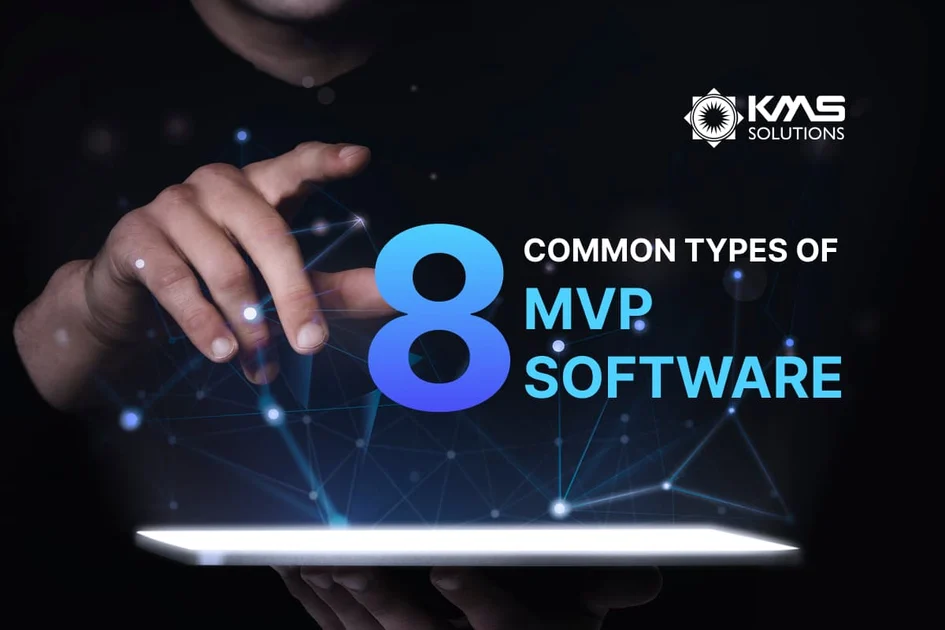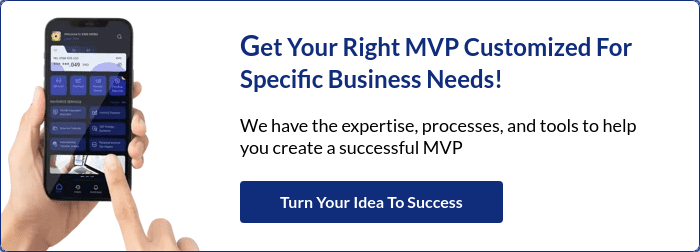While it comes to the features and functions of software products, ideas can be fantastic when they’re just that: ideas, but they’re difficult to put into practice in real life. One approach to get those big ideas off the ground is to create a Minimum Viable Product (MVP).
MVP software is essentially a test version of your product concept. While some may misunderstand this to mean building leaner products, the MVP concept in software development refers to generating the most basic version of a software product and using it as a test version. After that, the product may be tested, and the information gained from user input can be utilized to further shape and materialize the bespoke software product into a more tangible, fully-fledged product.
MVP Software Development: Why Do You Need It?
Developing an MVP has numerous benefits. These are some of them:
- Faster release: One of the key advantages of MVP development is that it reduces the time it takes to produce a product. You can quickly create a basic but fully working product, allowing you to take advantage of possibilities that arise in the fast-paced industry.
- Products that are useful: The focus is on building and refining the essential components of your product from the start. Underbuilding, feature creep, and rework time are all eliminated as a result.
- Room for evolution: Because MVP software development is incremental, it leaves the most room for your product to adapt in response to changing demands. This is crucial, particularly if you want your product to be future-proof.
Main Types of MVP Software
Understanding the many sorts of MVPs before beginning the construction of the MVP can help you make your notion more tangible. In a broad sense, all MVPs can be divided into two main categories: low-fidelity and high-fidelity.
- The low-fidelity MVPs include rather primitive concepts that can be validated without the use of complex or costly methods. As they are comparatively easy to develop, their main purpose is functioning basically to adapt to your basic requirements without comprehensive features.
- The other requires more sophisticated and resource-consuming techniques. If you have already identified the customers’ demands and have an idea, high-fidelity MVPs can be an appropriate choice as developers gather input from actual users to improve products.
|
Low-fidelity MVP
|
High-fidelity MVP | |
| Complexity | Require development at a basic level. | Profound results, demanding more complicated development. |
| Objectives |
– Analyse users’ challenges – Check the need for a solution – Identify efficient solution |
– Engage early adopters – Define the number of customers who are ready to pay – Get user feedback to optimise the product. |
| Types |
– “The Fake Door” – Landing page – Email campaign – Marketing campaign |
– Single-feature – Piecemeal MVP – Concierge MVP – Wizard of Oz MVP |
Low-Fidelity MVP Types
1. “The Fake Door” MVP
Also refers to “an MVP before an MVP”, it assists in evaluating interest in a product or specific feature without actual implementation. It is often a landing page that presents product’s information although the product hasn’t been built yet, allowing you to gauge market interest before risking time and effort creating an MVP or prototype.
For instance, the founder of Dropbox, Drew Houston opted to create a video demonstrating his app’s idea before actually developing it.
However, the big trouble with a fake door MVP is that you could come off as untrustworthy or scammy, possibly decreasing your credibility.
2. Landing Page MVP
This strategy takes the form of a video or plain text presentation that targets potential consumers. These presentations communicate your product’s idea and conceptual framework to people as a means to collect feedback from them without putting a lot of time and money into it.
This MVP approach is a great way to connect with your target users and allow you to future-proof software products. It is relatively inexpensive, simple to deploy, and can be used effectively to measure a unique value proposition.
However, as the landing page MVP highlights the interest in the product, there is no conversion factor provided. The data you collect is limited if visitors choose not to take action.
3. Email campaign MVP
This MVP approach is proper if you have an email database of potential customers and want to check if your new idea interests them. This is also suitable if you need to validate your value proposition in an affordable and fast way.
You also need to consider the drawbacks of email campaign MVP, which require a large database of user emails and only work best in tandem with other MVP types.
4. Marketing campaign MVP
A marketing campaign MVP includes a full-scale promotion of your app concept even when the app hasn’t been launched yet. Although this category of MVP can provide you with better reach than landing pages or emails, it requires significant time, effort, and money. Hence, it is best suited for larger companies with bigger budgets.
High-Fidelity MVP Types
5. MVP with a single feature
This methodology works by implementing one aspect of your product and putting it to the same test with people, as the name implies. While this approach may be controversial to some, it can help your product attain the success you seek. This concept has been implemented by a number of major businesses throughout the world, and it has proven to be quite successful.
Pokemon Go is an excellent example of a game that started with a single feature and grew once the test feature proved to be successful.
Development should focus on releasing the most valuable feature of the product while following the Single-feature MVP strategy. Consider your target audience and what features they would find most valuable in your offering. You should concentrate on the features that will meet their urgent demands.
6. Piecemeal MVP
The idea of this MVP is to use existing third-party tools and solutions to provide your product features. The development mostly comprises the usage of open-source or already written codes, as well as common interface templates. Its benefit is making development much faster and more affordable. Moreover, you can also use all the advantages of existing products to solve your customers’ problems.
Thus, piecemeal MVP is best suited for an app idea with advanced functionality but is limited in time and technical resources to develop it.
7. Concierge MVP
Concierge MVP emulates a software solution with multiple functions while a human performs its main functions. This means that the user is guided throughout the use of the product and is aware of this assistance.
Developing the concierge MVP can help evaluate the effectiveness and popularity of a solution before it is fully developed. This allows a business to save resources by ensuring that the final product will generate sufficient interest from the target audience. You can choose this type of MVP to learn customer behaviour and find the possible way to automate the provided services in a cost-efficient manner.
8. Wizard of Oz MVP
The MVP product developed based on this principle appears to be a fully functional product that includes all the necessary features. However, many of these features are manually processed and executed.
This approach is similar to a concierge MVP, where backend functions are handled by humans, but the distinction here is that the user is unaware of it. This type of MVP is particularly useful for testing ideas that require advanced technologies such as machine learning.
Nevertheless, it is challenging to ensure the consistency of interactions with customers due to the human factor behind the Wizard.
Which Type of MVP is Best Suited to Your Business Needs?
The chosen fidelity is determined by how closely the future MVP needs to look like the final product. In fact, there’re some businesses that develop product ideas based on urgent problems that arise in the market.
For instance, in 2020, the pandemic led to the demand for various online delivery tools and software for remote business operations and working from home. To accelerate the release process to address user needs timely, it makes sense to start with a low-fidelity MVP as it implies minimum investment and faster response. After that, you can consider moving to high-fidelity models after receiving feedback from users and identifying the main features of the software.
After defining the required fidelity, you can narrow down the suitable range of MVP categories by answering the following questions:
- What is the available time frame for creating an MVP and seeing results?
- How much is your budget? What amount can you spend on an MVP?
- What is the highest risk you currently have? How can you check it?
Choosing the Most Important Features for Your MVP Software
Fragmenting your idea to produce an MVP can be difficult, especially if you believe your entire concept is more clear when all pieces are present. As a result, the first and most important stage is to do extensive research on your product and how it fits into the market dynamics in which you operate. With all of the data in hand, you may divide your product features into the following categories:
Must-have
It might be a single feature or a group of characteristics that your product need. The guideline is that the features in this section are incredibly important in making your product simple and useful. As a result, they must be supported by adequate evidence to demonstrate their significance.
Ought to have
The “should have” features can assist in enhancing your product’s capability in future upgrades if you start with a simple offering. Depending on their importance level, this group might be further split. These may be included in the framework of your growing product over time.
Could have
These are characteristics that your product might work without, but adding them would not change the main concept of your product. Only implement the features listed below if they have been shown to improve the overall experience of using the product and if adequate resources are available for implementation.
Will not have
These characteristics you don’t want to include in your product, particularly if your study has revealed that they are irrelevant or do not add to your overall vision.
Sum up
An MVP idea goes widely beyond the single-feature software prototype. Various concept validation procedures are effective for different objectives and product kinds. Selecting the optimal MVP for a business enables cost- and time-efficient tests that provide actionable insights for future development. Moreover, it’s also vital to consider the features that you should build for each type of MVP approach to ensure that the released product can meet the basic needs of consumers.
KMS Solutions delivers the full line of MVP development services, helping enterprises select the appropriate MVP approach and develop demanded assets for successful business growth. Feel free to consult our software engineers and strategic specialists regarding your product development.











